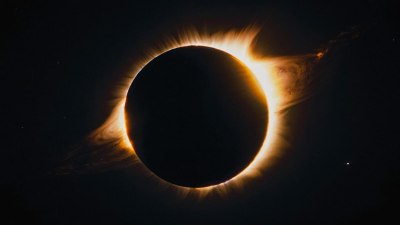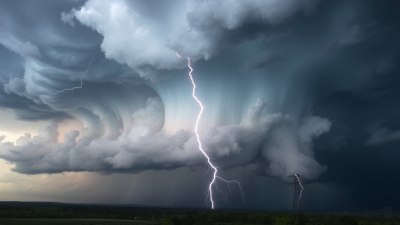What Happens in the Upper Atmosphere During a Solar Eclipse
Explore the fascinating effects of solar eclipses on the upper atmosphere and their implications for science.

Image by gulnoman585 on Freepik
A solar eclipse presents a unique opportunity for scientists to study the upper atmosphere, specifically the complex interplay between sunlight and the ionosphere. During a solar eclipse, the moon passes between the Earth and the sun, blocking a portion of the sun's light from reaching the Earth's surface. This event triggers a variety of atmospheric phenomena that can be both observed and measured, leading to significant insights into atmospheric science and solar-terrestrial interactions.
The upper atmosphere consists of various layers, including the troposphere, stratosphere, mesosphere, thermosphere, and exosphere. Among these, the ionosphere, which is part of the thermosphere, is particularly affected during a solar eclipse. The ionosphere is composed of ionized particles that reflect and refract radio waves, making it crucial for communication and GPS systems. A solar eclipse causes a sudden decrease in solar radiation, leading to a rapid drop in ionization levels. This drop can last for the duration of the eclipse and then gradually recover as sunlight returns.
Changes in Temperature
One of the immediate effects observed is a drop in temperature in the upper atmosphere. The reduction in solar radiation during an eclipse caused by the moon's shadow leads to a cooling of the atmosphere. Researchers have recorded temperature changes in the stratosphere and the mesosphere as high as 5 to 10 degrees Celsius. This cooling is more pronounced at higher altitudes, where the effects of diminished solar radiation are quickly felt. As a consequence, the variation in temperature can influence atmospheric circulation patterns, potentially altering weather conditions temporarily.
Ionospheric Response
The ionosphere plays a crucial role in communication systems around the world. During a solar eclipse, ionization levels fluctuate dramatically due to the sudden absence of sunlight. Typically, the ionosphere becomes highly ionized during the day when exposed to direct sunlight; however, during an eclipse, this ionization decreases significantly. This reduction can lead to immediate effects such as changes in radio wave propagation. Frequencies that typically rely on ionospheric reflection might encounter disruptions, leading to poor transmission quality during the event.
The dynamics of the ionosphere's response to a solar eclipse are not only a focus of academic inquiry but also essential for practical applications. It affects global positioning systems (GPS) and communication systems in aviation and maritime operations. As researchers study these changes, they gather critical data that can improve predictive models for how solar activity and celestial events influence Earth's atmosphere.
Effects on Atmospheric Dynamics
The sudden change in the solar input not only impacts temperature and ionization but also modifies atmospheric dynamics significantly. The cooling of the mesosphere and lower thermosphere creates an imbalance in pressure gradients. As the areas overshadowed by the moon cool faster than their surroundings, this temperature differential can lead to changes in wind patterns. Scientists have observed that wind speeds in the upper atmosphere can increase or shift direction during an eclipse, contributing to altered weather patterns at lower altitudes.
The rapid cooling can also instigate gravity waves. These waves are disturbances in the atmosphere that propagate due to variations in density and temperature. As cool air descends and warmer air rises, the interaction can lead to turbulence and fluctuations in air flow. These gravity waves may extend far beyond the region affected by the eclipse, potentially altering atmospheric conditions hundreds of kilometers away, showcasing the interconnectedness of atmospheric systems.
Photochemical Changes
Solar eclipses also have implications on photochemical reactions occurring in the atmosphere. Solar energy drives many chemical processes, particularly those involved in the formation and breakdown of pollutants and greenhouse gases. During an eclipse, reduced solar radiation can disrupt these reactions. For instance, the creation of ozone in the stratosphere is highly dependent on solar ultraviolet (UV) radiation. With diminished UV exposure, the production rates of ozone will decrease temporarily, which can be crucial in studies relating to climate change and air quality.
Research and Observations
Scientists utilize eclipses as opportunities for systematic study, setting up ground-based and satellite experiments to observe these atmospheric changes. Instruments, such as ionosondes and radiosondes, are employed to measure temperature, pressure, and ionization levels in real-time. The data collected during these events provide invaluable insights, contributing to our understanding of atmospheric behavior and the impacts of solar irradiance on the Earth’s climate system.
Historically, eclipses have provided critical information that has led to advancements in sciences ranging from meteorology to astronomy. For example, the 1919 solar eclipse was pivotal for Albert Einstein's general theory of relativity, confirming that light from stars could bend around the sun. Similarly, modern solar eclipses have opened new avenues of research focused on the upper atmosphere and its connection to solar phenomena, encouraging ongoing collaborations across scientific disciplines.
Solar eclipses provide a unique natural experiment that catalyzes a range of phenomena in the upper atmosphere. The temporary decrease in sunlight leads to remarkable changes in temperature, ionization, atmospheric dynamics, and photochemical processes. By studying these impacts, researchers expand our understanding of the atmospheric system and improve models that predict how solar and lunar activity affects climate and communications. As eclipses continue to occur, they will undoubtedly serve as prime opportunities for scientists to deepen their knowledge of both terrestrial and cosmic interactions.











